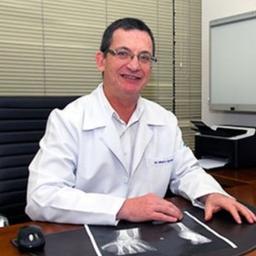Additional Filters
Orthopedic traumatologists
Found 5 orthopedic traumatologists
Dr. Mauro Zyman
Orthopedics, Traumatology and Hand Surgery in São Paulo
Hand surgeon
Dr. David Braz Del Giglio
Specialist in Pain, Orthopedics and Traumatology in São Paulo
Pain management specialist
Dr. Leonardo Roure Esteves
Orthopedists - Traumatologists in São Paulo
Orthopedic traumatologist
Dr. Wilson Dratcu
Orthopedist, Specialized in Orthopedic Fractures in São Paulo
Orthopedic traumatologist
Dr. Benedito Veras Batista Júnior
Specialist in Orthopedics and Traumatology in Teresina
Orthopedic traumatologist
Visitors who were interested in orthopedic traumatologists also searched for:
- Head Of Radius Replacement
- Total Hip Replacement Or Hemiarthroplasty Of Hip After Hip Neck Fracture
- Orthopedic Consultation
- Treatment Bone Loss
- Elbow Fracture Fixation
- Repair Of Ankle Fracture
- Distal Femur Fracture
- Suture Of Biceps Tendon
- Achilles Tendinitis And Tendinosis
- Orthokine System Injection For Tennis Elbow
Orthopedic traumatologists by cities
- Orthopedic traumatologist in Sao Paulo
- Orthopedic traumatologist in Rio de Janeiro
- Orthopedic traumatologist in Recife
- Orthopedic traumatologist in Porto Alegre
- Orthopedic traumatologist in Campinas
- Orthopedic traumatologist in Sao Luis
- Orthopedic traumatologist in Maceio
- Orthopedic traumatologist in Anapolis
- Orthopedic traumatologist in Campos dos Goytacazes
- Orthopedic traumatologist in Jundiai
Visitors who were interested in orthopedic traumatologists also searched for:
General information on medical treatment
What is an orthopedic traumatologist?
An orthopedic traumatologist is a physician specialized in the diagnosis, treatment, and prevention of diseases and injuries that affect bones, muscles, ligaments, and joints. They treat both traumatic injuries, such as fractures and sprains, as well as degenerative conditions, such as osteoarthritis. Their work involves precise diagnosis, which can lead to treatments with medication, physical therapy, or surgery, depending on the severity. Additionally, this professional provides guidance on preventive practices to avoid future injuries and promote long-term musculoskeletal health.
When to seek an orthopedic traumatologist?
You should seek an orthopedic traumatologist whenever you suffer a traumatic injury, such as a fracture or sprain, or when you feel persistent pain in your joints, muscles, or bones. If you have difficulties moving or performing simple activities due to joint pain, such as in the knees or shoulders, or if the pain intensifies after an accident, it is essential to consult this professional.
Additionally, if you are facing chronic pain or discomfort that compromises your quality of life, such as arthritis or back pain, the orthopedic traumatologist can perform a thorough medical evaluation, request tests, and prescribe appropriate treatment. The consultation is also indicated for prevention, especially if there is a family history of diseases such as osteoporosis or joint problems.
How does the orthopedic traumatologist treat fractures and injuries?
The orthopedic traumatologist is highly trained to treat fractures and injuries effectively, ensuring the patient's recovery with minimal complications. The treatment depends on the severity of the injury and the location of the fracture or injury.
Treatment of fractures
In cases of fractures, the first step is accurate diagnosis, performed through imaging tests, such as X-rays, to verify the extent of the injury. The treatment may vary according to the type of fracture:
Immobilization:
When the fracture does not require surgery, the orthopedist may choose to immobilize the affected area with plaster, splints, or other devices. This allows the bones to align and heal properly.
Surgery:
In more severe cases, such as fractures with displacement or that affect joints, surgery may be necessary to realign the bones and stabilize them with the use of pins, plates, or screws.
Pain control and recovery monitoring
Pain control is a fundamental part of the treatment of fractures and injuries. The orthopedic traumatologist prescribes appropriate medications to relieve discomfort, in addition to providing guidance on specific care to avoid complications.
During recovery, the doctor monitors the healing process through regular imaging tests, such as X-rays, to ensure that the fracture is healing correctly and that there are no problems such as infection or non-union of the bones.
Rehabilitation
After immobilization or surgery, the orthopedic traumatologist may recommend physical therapy sessions to restore mobility and strengthen the muscles around the injured area. Rehabilitation is essential to ensure that the patient recovers the full function of the affected region and avoids future complications.
The role of the orthopedic traumatologist in injury prevention
The orthopedic traumatologist is not limited to the treatment of injuries but also plays a crucial role in their prevention. They guide their patients on healthy habits to protect the musculoskeletal system and reduce the risk of fractures, sprains, and chronic diseases in the joints and bones.
The doctor recommends regular specific physical exercises, such as weight training, Pilates, and stretching, to strengthen muscles, improve flexibility, and maintain bone health. Additionally, they emphasize the importance of posture correction, especially during work and in daily activities, preventing problems such as back and neck pain.
In sports activities or high-risk professions, the use of appropriate protective equipment, such as knee pads and helmets, is essential to prevent injuries. The orthopedic traumatologist also provides guidance on maintaining a healthy weight, which reduces pressure on the joints and decreases the risk of diseases such as osteoarthritis.
What to expect from a consultation with an orthopedic traumatologist?
In a consultation with the orthopedic traumatologist, you can expect a thorough evaluation of your condition. The doctor will begin by listening to your symptoms, medical history, and performing a complete physical examination. Depending on the situation, they may request complementary tests, such as X-rays, magnetic resonance imaging, or tomography, to better understand the problem and establish an accurate diagnosis.
Based on the information obtained, the orthopedic traumatologist will present treatment options, which may include medications for pain control, physical therapy sessions, or, in more severe cases, the recommendation of surgery. The objective of the consultation is to provide an appropriate and personalized recovery plan, always aiming for the best possible recovery for the patient.
Subspecialties of orthopedics and traumatology
Orthopedics and traumatology has several subspecialties that allow for more specific and targeted treatment. Learn about the main areas of expertise of these specialists:
Pediatric Orthopedics:
Specialized in the treatment of children with congenital or acquired problems that affect the musculoskeletal system, such as clubfoot, hip dysplasia, and scoliosis.
Spine Surgery:
Focused on the diagnosis and treatment of conditions that affect the spine, such as herniated discs, spinal stenosis, and scoliosis, using minimally invasive techniques when possible.
Technological advances in modern orthopedics
Orthopedics has significantly benefited from recent technological advances, which have revolutionized diagnoses and treatments. Notable are minimally invasive techniques, such as arthroscopy, which allow surgeries with smaller incisions, less blood loss, and faster recovery.
3D printing is another important innovation, enabling the creation of personalized prostheses and implants that perfectly adapt to the patient's anatomy. Surgical robotics provides greater precision in complex procedures, such as knee and hip arthroplasties.
Most common injuries treated by the orthopedic traumatologist
The orthopedic traumatologist treats a wide variety of injuries that affect the musculoskeletal system. Among the most common are:
- Bone fractures
- Dislocations and subluxations
- Ligament injuries (such as anterior cruciate ligament rupture)
- Tendon injuries (such as tendinitis and Achilles tendon rupture)
- Muscle injuries (such as strains and contusions)
These injuries can occur during sports activities, traffic accidents, or even in everyday situations. Early diagnosis and proper treatment are essential to prevent future complications.
Bone health and osteoporosis prevention
Osteoporosis is a condition characterized by the progressive loss of bone mass, making bones more fragile and susceptible to fractures. The orthopedic traumatologist plays a fundamental role in the prevention and treatment of this condition.
A diet rich in calcium and vitamin D is essential to maintain bone health. Foods such as milk, yogurt, cheeses, green leafy vegetables, and fish are excellent sources of these nutrients. Moderate sun exposure also contributes to the production of vitamin D by the body.
Rehabilitation and physical therapy after orthopedic treatment
Rehabilitation is a crucial step in the treatment of orthopedic injuries, ensuring complete recovery of function and preventing recurrences. The orthopedist works together with physical therapists to develop a personalized rehabilitation program.
The rehabilitation process generally includes muscle strengthening exercises, stretching, balance and proprioception training. In some cases, resources such as electrotherapy, therapeutic ultrasound, and laser therapy may be used to accelerate recovery.
Sports orthopedics: prevention and treatment of injuries in athletes
Sports orthopedics is an area specialized in the treatment and prevention of injuries related to sports practice. Athletes are particularly subject to injuries due to overload and repetitive movements in their activities.
The orthopedist specialized in sports medicine evaluates not only the injury but also the biomechanical factors that may have contributed to its occurrence. The goal is not only to treat the injury but also to prevent recurrences through corrections in technique, appropriate equipment, and specific strengthening programs.
When is orthopedic surgery necessary?
Orthopedic surgery is recommended in specific cases, when conservative treatment options are not sufficient to promote the patient's recovery. The decision to opt for surgery is carefully evaluated, taking into consideration the severity of the injury, the response to initial treatment, the patient's age, and their general health condition.
In cases of unstable fractures, where the bones are misaligned and cannot heal without intervention, or severe ligament injuries that affect essential joints, surgery may be necessary to restore function and relieve pain. Additionally, in conditions of advanced arthrosis, where pain and functional limitation become intolerable, or in herniated discs that do not improve with non-invasive methods, surgery is frequently considered. Congenital or acquired deformities that compromise the patient's function and quality of life may also require surgical correction.
The decision to perform surgery should be made after a thorough analysis between the orthopedist and the patient, considering the treatment options, the potential benefits of surgery, and the risks involved, ensuring that the choice is the most appropriate for each situation.
Home care after orthopedic procedures
Home care is fundamental to the success of orthopedic treatment. The orthopedic traumatologist provides specific guidance on how the patient should proceed during recovery, including rest, application of ice or heat, and elevation of the affected limb when appropriate.
It is essential to correctly follow the recommendations on the use of crutches, walkers, or other mobility aid devices. It is also important to be alert to signs of complications, such as increased pain, excessive swelling, fever, or changes in skin color.
The impact of digital technology in orthopedics
Telemedicine has become an increasingly important tool in orthopedics, allowing for follow-up consultations and initial assessments remotely. This is especially valuable for patients with reduced mobility or who live in areas distant from medical centers.
Specific health applications for orthopedics help patients follow their rehabilitation exercise programs, monitor their progress, and maintain communication with their doctors. Wearables can also provide valuable data on posture, movement patterns, and joint load.
How can AvaliaMed help you find the ideal orthopedic traumatologist for you?
AvaliaMed is a platform that simplifies the search for the ideal orthopedic traumatologist for your case, offering a vast selection of specialized doctors. Through the platform, you can access detailed information about the training, experience, and specializations of each professional, making it easier to choose the most suitable specialist.
Additionally, AvaliaMed allows you to consult evaluations from other patients, offering a clearer view of the quality of care and the effectiveness of treatments. The platform also offers the convenience of scheduling appointments directly through the website, providing an agile and uncomplicated experience. If you have questions, you can contact the doctors before the consultation, making the process even more comfortable and safe.
Frequently Asked Questions
Disclaimer
This website provides general information and insights from third parties. It is not a replacement for professional medical advice. Please consult a healthcare professional before making any decisions based on the information on this website. Be aware that you bear full and exclusive responsibility for the use of this website and its contents.
About
Contact UsAbout AvaliaMedPrivacy PolicyTerms of UseAccessibility StatementList your Practice on AvaliaMedPhoto GalleryMedical ArticlesLog inSpecialities
Aesthetic medicineOrthopedic SurgeonsGynecologistsPlastic SurgeonsDermatologistsEye DoctorsDentistsUrologistsClínicasHospitals
Sirio-Libanes HospitalAlbert Einstein Israelite HospitalHospital of the ClinicsSamaritano HospitalAlbert Sabin Israelite HospitalTreatments
Botox injectionDermoscopyColposcopyTummytuckIVFTooth Implantation ProcedureScoliosisPain managementCataract surgeryHypospadias repairTreatments
Cardiac catheterizationGastroscopyHeadachesADHD in AdultsFace sculpterExtractionsOrthopedic consultationStrabismus surgeryPregnancy followupBreast lift



